iPad, iPad Pro, iPad mini, iPad Air… that’s a lot of iPads for the average person who isn’t an ardent follower of Apple and its products. It’s hard to make sense of all these names, especially when you add in the variations in models over the years.
In this article, we don’t aim to explain the differences between Apple’s various touchscreen tablets, but at least to help you tell the difference between the classic iPad and the popular iPad Air.
Why are iPad tablets so popular?
First and foremost, the iPad is a tablet from Apple, a brand with a worldwide reputation. A brand that has based its marketing on innovation, always one step ahead of the competition, while offering intuitive, easy-to-use products.
Apple’s marketing is meticulous, polished and mastered from start to finish. From the presentation of new products during Keynotes to the Apple Store, where products can be tested and repaired, the brand’s managers make sure they control every aspect of the promotion of their products.
This is why iPad tablets are so popular with the public. They are a product of the world-famous brand and therefore enjoy the same qualities (or at least the same reputation) as the brand’s smartphones and computers.
The iPad tablet
The Apple iPad tablet has a proven track record on the market, and is available in a wide range of versions to satisfy as many consumers as possible. Storage space ranging from 64GB to 256GB, a subscription limited to WiFi or 4G compatible, the option of using an Apple Pencil for applications requiring precision… so many options and choices designed to win over as many customers as possible.
For those who need to write texts, the Apple iPad is compatible with Smart Keyboard: plug it in and your tablet is transformed into a small laptop ready to accompany you on your travels.
The iPad Air tablet
The Apple iPad Air is a little lighter than the iPad, weighing around thirty grams less, but that’s obviously not the biggest difference. Above all, the iPad Air is more powerful than its iPad counterpart, while offering the same variations in storage memory, from 64GB to 256GB depending on the model. The iPad Air is also thinner than the classic iPad, making it a more mobile and flexible tablet.
On the iPad Air, you can adjust the intensity and colour of your screen to suit the ambient light, and you can choose your iPad Air from a range of colours so you can enjoy a tablet to suit your taste.
Finally, as you may have guessed, the iPad Air is more expensive than the classic iPad. The latter is more suited to customers looking for a ‘cheap’ device, while the iPad Air is aimed at users with a bigger budget.

